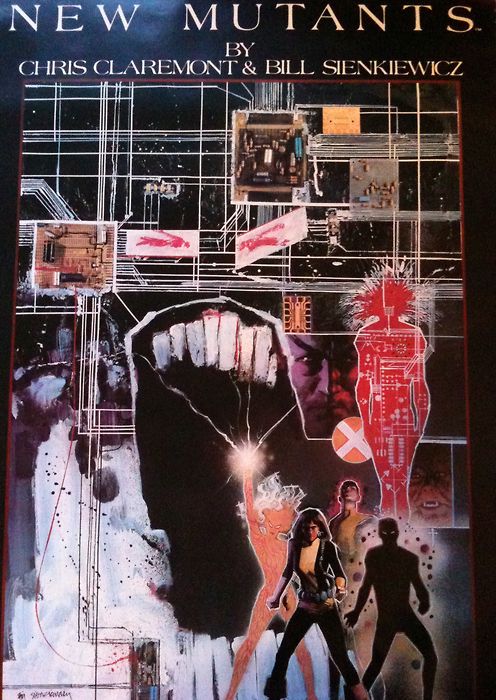There were a few other Edmonton comic shops from the time that I visited but no longer remember. I’ve hunted online for any trace of these shops and they are, I’m sure, long gone and exist now only in the memories of those who shopped at them.
I recall one shop located on Stony Plain Road that I visited some time in 1986. I know the year because the woman who was working there was having a loud conversation with a friend about how much she was enjoying both Frank Miller’s The Dark Knight Returns and John Byrne’s The Man of Steel. There were plenty of back issues in this shop, which is what I remember the most. And I remember scoring a beautiful copy, that I still own today, of this pivotal issue of X-Men:

This was my first issue with Paul Smith art and, when I got it home, I loved it. Loved, loved, loved it. It was double-size, had all kinds of amazing stuff happening in it, and it concluded the long-running Brood saga with a satisfying punch — and still ended with a cliff-hanger that ensured next issue was going to be even better. This was a high point of writer Chris Claremont’s long run and did a lot to cement X-Men as my favorite comic book.
The other shop I recall was located in West Edmonton Mall. For those who don’t know, WEM was as much an amusement park and tourist attraction as it was shopping mall. When it opened in 1981, it was just a nice mall. Big for the times, but nothing too special. It had the usual anchor stores, food court and movie theater (six screens!) where I saw Time Bandits more than once. In 1983, the mall doubled in size and exposed its ambitions, adding an NHL-size skating rink, even more movie screens, a huge McDonalds, and an amusement park area called Fantasyland that featured a handful of rides and attractions for mostly younger kids. In 1985, it doubled in size again, adding a third set of movie screens, a second food court, submarine rides, a dolphin tank, a replica of Christopher Columbus’ Santa Maria, miniature golf, a massive water park with a wave pool and slides, and two theme streets: Europa Street, which evoked a European feel for high-end fashion stores as tenants, and Bourbon Street, with restaurants and bars for lovers of the night life. There was a hotel with theme rooms planned, and Fantasyland doubled in size, adding a triple loop rollercoaster and “drop of doom” style ride for older thrillseekers. Yes, it was a lot. And legal action from Disney did prompt a name change from Fantasyland to Galaxyland.

When the second phase opened, it included an area for smaller retailers who sold things like sunglasses and jewelry. I forget the name of that part of the mall, but it was located above the massive video arcade in Fantasyland. You’d take an escalator up from Fantasyland, and then if you went to the immediate left, there was a small comics shop that sold new issues and had a modest selection of back issues. I remember buying there a copy of Power Pack #1 for $3, which was a good deal at the time. And the store ended up being drawn by former Edmonton resident John Byrne into Alpha Flight #26 (Sept. 1985).

The issue starts with Alpha Flight — newly reunited in the previous issue with its founder, Guardian, who was believed killed in Alpha Flight #12 — undergoing a training exercise with the Canadian Military near Red Deer, Alberta. This takes up 12 pages of the issue’s 22 pages. Guardian then gets a message from his wife, Heather Hudson, that Alpha Flight is needed at West Edmonton Mall! They arrive and some man in a suit tells them everyone was chased out of the mall by these super-powered types who called themselves Omega Flight! The team splits up and each member is defeated by a member of Omega Flight — with help from a mysterious benefactor. Finally, we find Heather, who’s in front of the mall’s real comic shop when Guardian finds her.

Byrne draws the shop pretty much exactly as I remember it, though there appears to be more Byrne issues on sale there than I remember them having.
The story concludes with Guardian revealing himself to not be James McDonald Hudson, but the android that previously posed as Delphine Courtney in the death of Guardian arc. The story continues into Alpha Flight #27 (Oct. 1985), Secret Wars II #4 (Oct. 1985) and concluded in Alpha Flight #28 (Nov. 1985), which was Byrne’s last as writer and artist on the series.
The comic shop eventually moved to a larger retail space on the lower floor. There, it was the last comic shop I visited prior to our family’s move to Arizona. I distinctly remember that visit, and buying copies of the just-released X-Men #213 (Jan. 1987) with Sabretooth fighting Wolverine on the cover, and a copy of The ‘Nam #2 (Jan. 1987), which I had seen in a report on one of the American network news shows and decided to give it a look.
The only other comic shop I can recall was in the now-defunct Heritage Mall. It was mostly a gaming store, but they did have a small rack of comics and I recall thumbing through copies of Star Wars #104 (March 1986) and Power Pack #21 (April 1986) there, likely while just killing time until the next bus home.
And that’s it for Edmonton comics shops. I’ll do one more post on my newsstand experiences there, then move on to shops in Arizona.





































